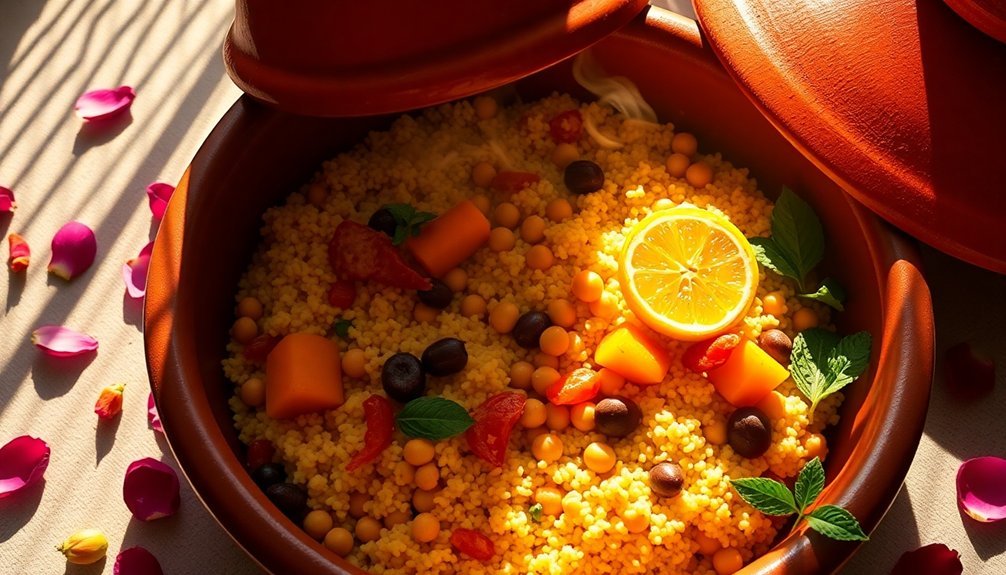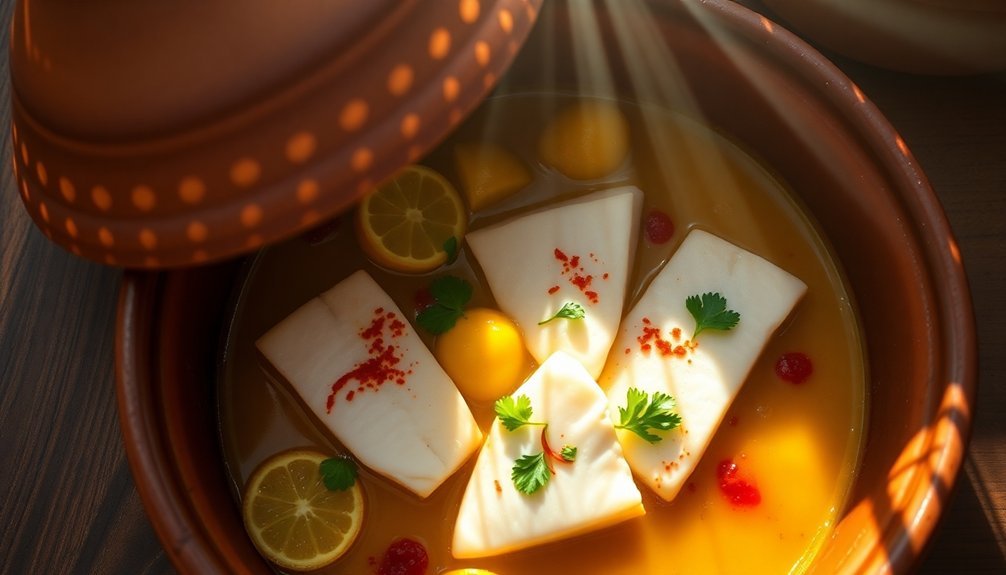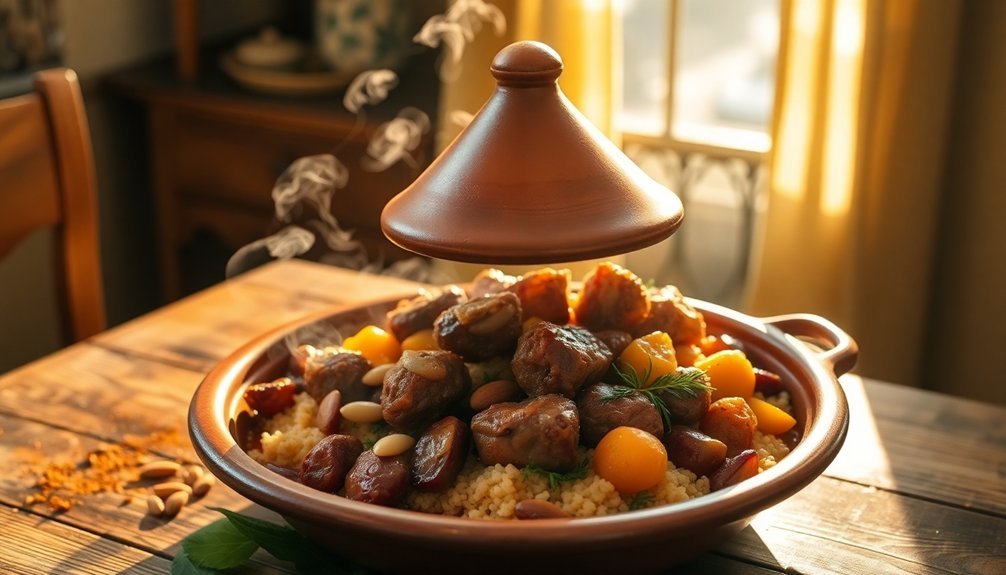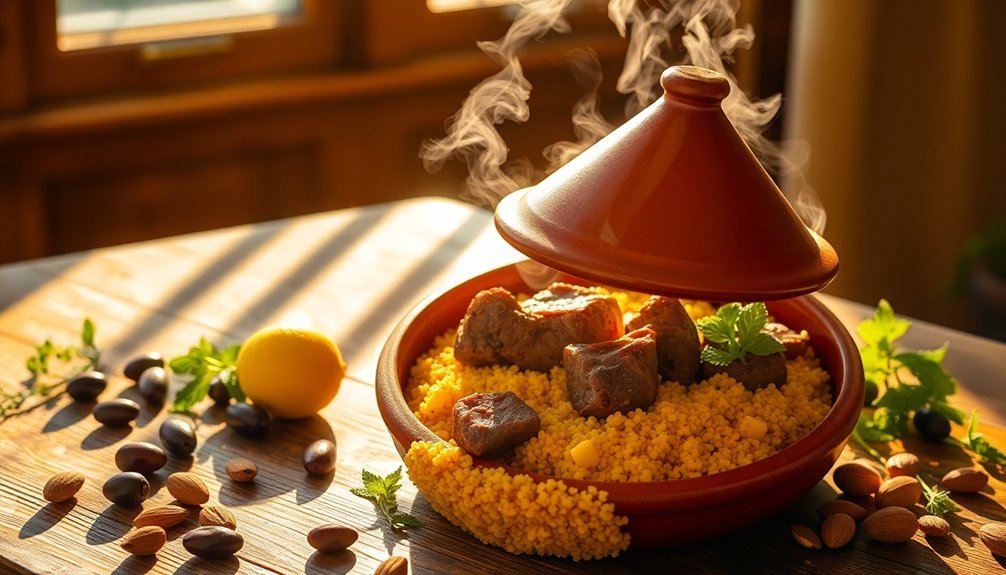Looking to harness the sun's energy for authentic Moroccan cooking? You'll love these seven flavorful tagine recipes perfectly suited for solar cooking. Start with the classic lamb tagine infused with cinnamon and saffron, or try the spiced chicken with sweet apricots. For lighter options, explore the vegetable couscous tagine or the fish with preserved lemon. The root vegetable medley offers a hearty vegetarian choice, while Moroccan meatballs provide a family-friendly twist. Don't miss the honey date tagine for a sweet-savory finish. These slow-cooked, one-pot wonders will transform your outdoor cooking experience and reveal the secrets of traditional Moroccan cuisine.
Traditional Lamb Tagine

In the heart of Moroccan cuisine, the traditional lamb tagine stands as a masterpiece of slow-cooking artistry. You'll start by marinating lamb cubes or shanks in a robust blend of cinnamon, coriander, paprika, and ginger, mixed with olive oil and minced garlic. Let this mixture develop its flavors for at least 3 hours, though overnight marination yields better results.
Begin cooking by sweating diced onions in generous olive oil until they're soft and translucent. For authentic preparation, sweat onions for 20 minutes before adding the marinated lamb and browning it thoroughly, stirring frequently to guarantee even cooking.
You'll then combine warm broth with tomato paste and cornstarch, whisking them together before adding to your tagine. Don't forget to incorporate saffron threads (steeped in water) and cardamom pods wrapped in cheesecloth.
Cover your tagine and let it simmer on low heat for 1-2 hours until the lamb becomes tender. If you're using an oven, maintain a temperature between 275-350°F to protect your tagine from cracking.
Add dried apricots and pistachios during cooking for texture and sweetness. Once the sauce reaches your desired consistency, serve your tagine over couscous or with traditional Moroccan bread.
Spiced Chicken With Apricots
You'll need chicken (either fillets, thighs, or drumsticks), dried apricots, Moroccan spices, tomatoes, and fresh herbs for this flavorful tagine.
Start by marinating your chicken for at least 2 hours with onions and spices, then brown the meat before layering it in the tagine pot with plumped apricots and aromatics.
The entire cooking process takes about 2 hours over slow heat, allowing the sauce to reduce and thicken while the chicken becomes tender and infused with the spiced flavors. The conical lid design helps return moisture to the dish during cooking, ensuring perfectly tender results.
Essential Ingredients Needed
Creating an authentic Moroccan tagine starts with gathering the right mix of proteins, aromatics, and seasonings.
You'll need bone-in, skin-on chicken pieces, preferably thighs and drumsticks, as they'll remain tender throughout the slow cooking process. Your aromatics should include finely chopped onions, minced garlic, and fresh grated ginger, which form the foundation of the dish's complex flavors.
For the signature Moroccan spice blend, you'll want ground cumin, coriander, turmeric, and paprika. These spices work together to create the dish's distinctive warm, earthy profile. The extensive use of these spices reflects Morocco's diversified culinary heritage developed over centuries of cultural exchange.
Don't forget to include dried fruits like halved apricots and raisins, which add natural sweetness and texture. You'll also need slivered almonds and preserved lemon for authentic North African flavor.
The liquid components are vital – use low-sodium chicken stock as your base, enhanced with a touch of honey or brown sugar for balance. You can add harissa paste if you'd like some heat.
Complete your ingredient list with butternut squash or sweet potatoes, canned tomatoes, and olives. These vegetables will absorb the fragrant sauce and complete your one-pot meal.
Cooking Time And Steps
Begin your Moroccan tagine journey by heating olive oil in a large skillet or Dutch oven over medium-high heat. Brown your chicken pieces until they're golden on each side, about 3-5 minutes per side, then set them aside.
Cook your onions until softened, roughly 2-7 minutes, followed by garlic for an additional minute.
You'll want to combine your spices in a small bowl – cumin, coriander, ginger, and cinnamon – then stir them into the onion-garlic mixture. Add your crushed tomatoes, chicken broth, honey, and lemon juice. If you're using dried apricots, raisins, or green olives, add them now and stir everything together.
Reduce the heat to low, bring to a simmer, and return your chicken to the skillet. Cover and cook for 1-3 hours, checking liquid levels every 20-30 minutes. Add water if needed to prevent drying.
When you're about 45 minutes from serving, add any vegetables like carrots, potatoes, or peas.
Once your chicken's tender and reaches 165°F, serve your tagine over couscous or rice. Don't forget to garnish with fresh herbs, a squeeze of lemon, and toasted nuts for the perfect finish.
Vegetable Couscous Solar Tagine

For your vegetable couscous solar tagine, you'll want to start with a vibrant blend of fresh herbs like parsley, mint, and coriander that can withstand prolonged sun exposure while infusing maximum flavor.
When selecting vegetables, opt for hearty root varieties such as sweet potatoes, carrots, and turnips that maintain their structure during slow solar cooking.
Layer your couscous strategically by placing it on top of the vegetables during the final 15 minutes of cooking, allowing it to steam perfectly while catching the aromatic essences from below.
Fresh Herb Infusion Mix
A vibrant herb infusion mix elevates your Moroccan couscous from simple to sublime. You'll want to start by finely chopping fresh parsley and mint, which will release their essential oils and intensify their flavors.
Mix these herbs into your cooked and fluffed couscous, along with a generous squeeze of fresh lemon juice and minced garlic.
To create a deeper flavor profile, cook your couscous in vegetable stock or herb-infused hot water instead of plain water. You can enhance the texture by adding chopped almonds, and don't forget to season with salt and black pepper to balance the flavors perfectly.
When combining with your solar tagine, pour some of the tagine's cooking liquid into the couscous for added depth.
For serving, you'll create layers of flavor by adding chickpeas and olives from your tagine. Top your dish with additional fresh herbs, pumpkin seeds, or pomegranate seeds for visual appeal and texture.
If you're looking to experiment, try incorporating dried fruits like apricots or dates for a sweet and savory contrast. For a gluten-free option, you can substitute quinoa for the couscous while maintaining the same herb infusion technique.
Sun-Ready Veggie Selection
Now that you've mastered the herb infusion, selecting the right vegetables for your solar tagine will make or break your dish.
You'll want to create layers of texture and flavor by combining different vegetable families that cook well in the sunlight.
Start with a base of aromatics: dice your onions, crush your garlic, and grate fresh ginger. These will form the foundation of your tagine's rich flavor profile.
Add chopped red and yellow bell peppers for a sweet crunch and vibrant color that'll make your dish visually appealing while providing essential vitamins and antioxidants.
Layer in your root vegetables next – cubed sweet potatoes, carrots, turnips, and parsnips. These hearty vegetables will maintain their structure during the slow solar cooking process while delivering sustained energy and fiber.
For the final layer, incorporate softer vegetables like zucchini, courgette, and eggplant. These moisture-rich additions will help create the signature tagine sauce as they cook down.
Don't forget to include fresh or canned tomatoes – they'll break down during cooking to create a rich base that ties all your vegetables together in perfect harmony.
Couscous Layering Technique
Creating the perfect couscous layer in your solar tagine requires mastering a delicate balance between texture and moisture. While traditional methods use a couscoussier, you'll need to adapt your technique for solar cooking by focusing on proper layering and timing.
Start by preparing your couscous with hot chicken broth, turmeric, and olive oil. Once you've removed it from heat and let it stand for 5 minutes, fluff it with a fork to guarantee each grain separates perfectly.
You'll want to roast your vegetables – bell peppers, eggplant, and zucchini – before incorporating them into the dish.
Layer your ingredients strategically: spread the fluffy couscous as your foundation, then add your roasted vegetables, chickpeas, and carrots. Sprinkle almonds throughout for crunch and texture variation.
You'll enhance the flavors by drizzling a dressing made from olive oil, lemon juice, and aromatic spices like coriander and cumin over the top. Don't forget to incorporate fresh parsley for brightness and color.
Toss everything gently to combine, making sure the dressing coats all ingredients evenly. This layering technique guarantees each component maintains its distinct texture while melding into a cohesive dish.
Moroccan Meatballs in Sauce
Tender, aromatic Moroccan meatballs transform a simple tomato sauce into an irresistible tagine-style dish. You'll need ground meat (beef, lamb, or turkey), combined with grated onions, fresh herbs, and a warming blend of spices including cumin, paprika, and cinnamon.
Mix these ingredients with breadcrumbs and minced garlic, being careful not to overwork the meat.
While your shaped meatballs rest, you'll prepare the vibrant tomato sauce. Start by sautéing onions and garlic in olive oil until they're translucent. Add your choice of tomatoes – crushed, passata, or fresh chopped – along with the signature Moroccan spice blend.
Let the sauce simmer for 15-20 minutes, then blend it for a silky-smooth consistency.
You'll gently add your meatballs to the simmering sauce, cooking until they reach 165°F internally. If the sauce becomes too thick, you can thin it with a splash of water.
Serve your tagine-style meatballs over fluffy couscous, garnished with fresh herbs and olives. For an authentic touch, you can crack eggs into the sauce during the final minutes of cooking.
Fish and Preserved Lemon

When you're craving a light yet flavorful tagine, this Fish and Preserved Lemon version delivers an exquisite balance of citrus and aromatic spices.
You'll need about 900g of cod or any firm white fish, cut into pieces, which you'll marinate in chermoula for at least two hours or overnight for the best results.
Start by preparing your vegetables: slice onions, bell peppers, and tomatoes into rings, and cut potatoes into thin rounds.
You'll want to coat the potatoes with a mixture of ginger, turmeric, salt, pepper, and olive oil.
Layer your ingredients in a tagine or deep skillet, starting with onions at the bottom, followed by the seasoned potatoes, tomatoes, and your marinated fish on top.
Pour diluted chermoula marinade and water over your ingredients, then simmer on low heat until the fish is cooked through and the vegetables are tender.
You can enhance the dish's authenticity by adding preserved lemon quarters, olives, and fresh herbs.
For the finishing touch, garnish with parsley or cilantro and serve with traditional Moroccan bread.
Root Vegetables With Herbs
A hearty root vegetable tagine brings out the natural sweetness and depth of winter vegetables through slow cooking. You'll find this dish particularly satisfying with combinations of carrots, parsnips, sweet potatoes, and turnips, while adding butternut squash and beetroot can provide extra variety and nutrition.
Start by sautéing onions and garlic in your tagine pot, then layer your chosen root vegetables. You'll want to season them with warming spices like cumin, turmeric, and cinnamon, or try a traditional ras el hanout blend for authentic Moroccan flavor.
Don't forget to add garlic and ginger for extra depth. To create a rich sauce, you'll need diced tomatoes or passata, along with low-sodium vegetable broth.
Add chickpeas for protein and throw in some dried apricots or dates for a subtle sweetness that complements the root vegetables. You can enhance the dish with green olives for a savory contrast.
Let everything simmer slowly until the vegetables are tender. Serve your tagine over couscous or rice, and finish with a generous sprinkle of fresh parsley and coriander, plus some toasted almonds for crunch.
Sweet Honey Date Tagine

Rich with sweet and savory flavors, this honey date tagine combines succulent chicken pieces with sticky dates and golden honey for a luxurious Moroccan feast. You'll start by browning your chicken thighs in oil until they're golden, then sautéing aromatics before adding your warming spices like ginger, cumin, and cinnamon.
| Element | Sensation |
|---|---|
| Dates | Sweet, caramelized bliss |
| Honey | Golden warmth |
| Almonds | Toasted crunch |
| Spices | Aromatic comfort |
| Chicken | Tender succulence |
Pour in your chicken stock and tomatoes, letting everything simmer until the chicken's tender. You'll notice the sauce thickening as it reduces, creating an irresistible blend of sweet and savory notes. Add your chopped dates and a drizzle of honey towards the end, allowing them to meld with the sauce.
For the finishing touch, sprinkle toasted almonds over your tagine, adding a satisfying crunch to each bite. If you're feeling adventurous, include dried apricots or raisins for extra sweetness. Don't forget to taste and adjust the seasoning – you're looking for that perfect balance between the honey's sweetness and the spices' warmth.
Frequently Asked Questions
Can Solar Cooking Times Vary Based on Weather Conditions and Sunlight Intensity?
Yes, your solar cooking times will vary considerably. You'll need longer cooking periods during cloudy weather, while intense direct sunlight speeds up cooking. Cloud cover, seasonal changes, and time of day directly affect efficiency.
How Do You Prevent a Clay Tagine From Cracking During Solar Cooking?
You'll need to warm your tagine gradually in the sun, use a heat diffuser underneath, avoid sudden temperature changes, and never place it directly on cold surfaces. Always maintain consistent temperatures during cooking.
Which Alternative Cooking Vessels Work Well for Solar Tagine Cooking?
You'll find Dutch ovens and cast iron casseroles work exceptionally well for solar tagine cooking. They retain moisture and heat effectively, while solar-adapted slow cookers and multiple-pot solar cookers can also produce great results.
Is Preheating the Solar Cooker Necessary Before Adding the Tagine Pot?
Yes, you'll definitely want to preheat your solar cooker for ideal tagine results. It helps maintain consistent temperatures and reduces overall cooking time. For best results, preheat for at least an hour before adding your pot.
What Temperature Range Should Be Maintained for Safe Solar Tagine Cooking?
You'll need to maintain temperatures between 180°F (82°C) and 300°F (149°C) for safe tagine cooking. For best results, aim to keep your solar cooker around 200-300°F (93-149°C) throughout the cooking process.
In Summary
You'll find these solar tagine recipes bring authentic Moroccan flavors right to your table while harnessing the power of sunlight. Whether you're craving tender lamb, aromatic chicken, or vegetarian delights, there's a one-pot wonder waiting for you. Don't forget to let the ingredients slowly meld together under the sun's warmth – that's the secret to developing those rich, complex flavors that make tagine cooking so special.





Leave a Reply